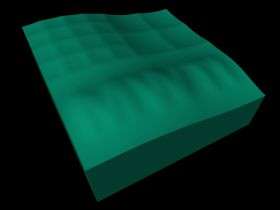Writing patterns, logos and lettering in light

(PhysOrg.com) -- Logos and lettering can be written in light using freeform lenses. But how does the surface of the lens have to be structured in order to focus the light in the shape of a specific pattern? This used to be a task that took hours – now it can be done in a few seconds.
Over the main entrance to an industrial site, a lamp projects the lettering of the company’s logo onto a wall near the reception area. The sign is created by a freeform lens with a complex surface that directs the light in a defined pattern. Freeform lenses can be used in many other applications.
For instance, the outside walls of a house can be illuminated in such a way that no light penetrates through the windows that might dazzle occupants. The lenses can also be used in medicine, to direct light onto the specific site where a surgeon is operating. The special feature of these lenses is that they generate an image directly, without the need for a template or transparency. This saves energy, and produces more sharply defined images.
It is relatively easy to calculate the shape of an image to be created by a freeform lens. But it is far more difficult to define the surface structure of the lens required to project a specific image, such as a logo. Until now, it was more a case of trial and error. The developers would run a simulation of a lens shaped in approximately the desired pattern, study the image it produces, and gradually adjust the shape of the lens until it focuses the light in exactly the right pattern.
“The process could take several hours,” says Dr. Robert Feßler, a research scientist at the Fraunhofer Institute for Industrial Mathematics ITWM in Kaisers-lautern. Now the same task can be accomplished in a matter of seconds. ITWM researchers have developed a software program capable of calculating the lens geometry corresponding to the coordinates of a desired image in next to no time. It is the first software of this type to be offered on the commercial market. “Different values can be entered for a variety of parameters. These might relate to the specific operating characteristics of the milling machine, or the material used to produce the lens,” explains ITWM project manager Dr. Nobert Siedow.
Because the software solution is capable of calculating the surface geometry of the lens within seconds, it is easy to optimize the result. For instance, if the curvature of the lens required for a specific image is too great, this may cause technical problems when it is manufactured. A limit value for the curvature can be set in the software, and the lens geometry can be recalculated with a few mouse clicks.
A demonstration version of the software is already available, and will be presented live at the Vision trade fair in Stuttgart from November 4 to 6. Visitors can have their photo taken, and the software will calculate the geometry of the freeform lens required to create this image.
Provided by Fraunhofer-Gesellschaft





















